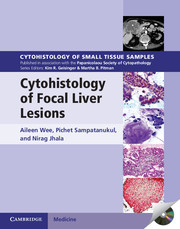Book contents
- Frontmatter
- Dedication
- Contents
- CONTRIBUTING AUTHOR
- Preface
- 1 The focal liver lesion: general considerations
- 2 Morphologic approach
- 3 Diagnostic algorithm
- 4 Focal liver lesions with low or no suspicion of malignancy
- 5 Focal liver lesions suspicious of hepatocellular carcinoma
- 6 Focal liver lesions suspicious of intrahepatic cholangiocarcinoma
- 7 Focal liver lesions from metastases and other malignancies
- 8 Focal liver lesions with cystic appearance
- 9 Focal liver lesions in infants and children
- 10 Ancillary studies
- 11 Techniques and technology in practice
- Index
7 - Focal liver lesions from metastases and other malignancies
Published online by Cambridge University Press: 05 April 2015
- Frontmatter
- Dedication
- Contents
- CONTRIBUTING AUTHOR
- Preface
- 1 The focal liver lesion: general considerations
- 2 Morphologic approach
- 3 Diagnostic algorithm
- 4 Focal liver lesions with low or no suspicion of malignancy
- 5 Focal liver lesions suspicious of hepatocellular carcinoma
- 6 Focal liver lesions suspicious of intrahepatic cholangiocarcinoma
- 7 Focal liver lesions from metastases and other malignancies
- 8 Focal liver lesions with cystic appearance
- 9 Focal liver lesions in infants and children
- 10 Ancillary studies
- 11 Techniques and technology in practice
- Index
Summary
INTRODUCTION
The vast majority of malignancies found in the liver are metastases and just about every tumor from every site in the body has been described. A noncirrhotic liver with multiple nodules is the prototypical radiologic finding (Fig. 7.1). Metastatic tumors tend to recapitulate their histologic appearance in the primary site. However, some of them can originate in the liver and others can mimic hepatocellular carcinoma (HCC) and intrahepatic cholangiocarcinoma (ICC). The cell of origin may be established from immunohistochemical studies but the primary site may not be determinable without clinicoradiologic correlation. Distinction between primary and metastatic malignancy has obvious therapeutic and prognostic significance.
CLINICAL PERSPECTIVE
Patients fall into several clinical settings: (i) radiologic surveillance for recurrence and metastatic disease in known cancer patients; (ii) investigation for symptomatology referable to primary tumor and/or liver secondaries, such as obstructive jaundice, right hypochondrial pain, or hepatomegaly; and (iii) routine health screening revealing abnormal liver function test profiles, elevated tumor markers, or imaging abnormalities. Patients may be asymptomatic or present with already advanced disease.
Metastatic tumors commonly encountered in the liver include those from colorectum, pancreas, stomach, breast, lung, skin, and bladder; most of which are carcinomas. Metastatic melanoma is more likely in the white population. Lymphomatous involvement is not uncommon, although the nodular form of primary hepatic lymphoma is rare. Less common but diagnostically more challenging are metastases from the kidney and adrenal gland due to their deceptively close mimicry of HCC. Sarcomas are rare, the most common being metastatic uterine leiomyosarcoma.
RADIOLOGIC PERSPECTIVE
The liver is the most common intra-abdominal organ for metastases. They are often multiple with variable appearances depending on the primary site (Fig. 7.2). On ultrasound, most metastases appear as hypoechoic masses. On computerized tomography (CT), metastases can be hypodense, isodense, or hyperdense, usually the former. Hyperdense metastases can be seen in carcinoid tumor and mucinous adenocarcinoma of colon when they calcify. The latter can also give rise to cystic metastases. Some metastases have a nonspecific target-like appearance. Rarely, the whole liver may be infiltrated by multiple small metastases, leading to diffuse hepatomegaly with heterogeneous appearance, particularly in lymphomas and miliary neuroendocrine metastases.
- Type
- Chapter
- Information
- Cytohistology of Focal Liver Lesions , pp. 171 - 213Publisher: Cambridge University PressPrint publication year: 2000

